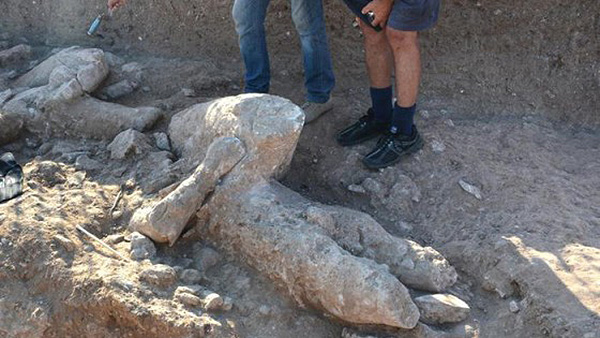Art World
Ancient Sculptures in Sardinia Rewrite Mediterranean History
Two new Giants of Mont'e Prama may be the region's oldest statues ever discovered.

Two new Giants of Mont'e Prama may be the region's oldest statues ever discovered.

The Mont’e Prama archeological site, located in Sardinia’s Oristano province, isn’t exactly a fresh find for the archeological community. The site was discovered 40 years ago by a farmer named Battista Meli whose plow hit a particularly stubborn rock in 1974. That rock turned out to be one of an estimated 33 fragmented statues, which have come to be known as the Giants of Mont’e Prama. Archeologists recovered over 5,000 pieces of the statues over the next five years and have reconstructed many of them. Many suppositions about their origins and significance to the island’s ancient Nuragic culture (18th century BC – 2nd century AD) have arisen since their discovery. But little has been proven.
That changed at the end of last month, according to La Repubblica, as two new giants were found at the site, almost entirely intact. A third giant may still lie beneath the first pair, according to ground-penetrating radar used by researchers. The scans have produced what they’ve thus far only qualified as “anomalies.” But with the initial pair having been lifted from the site and transported to the Museo civico di Cabras, further deeper excavations can now begin.
The new pair of Mont’e Prama Giants is estimated to date to the 8th century B.C. and are approximately two meters in length (6 feet). Their near-complete state has led researchers to already make several significant suppositions that pundits have said could rewrite the history of the Mediterranean region.
Oldest Examples of Colossi (giant sculptures)
Most significant is the position in which the two giants are depicted. The earlier, fragmented sculptures were found to be holding their shields above their heads. However, these latest examples hold their shields next to their torsos. According to archeologists with whom La Repubblica spoke, the position is strikingly similar to that of an Etruscan bronze from the same period found in Italy’s Viterbo province on the mainland, north of Rome. If the link can be proven, it would make the pair the oldest examples of Colossi (giant sculptures) ever found in the Mediterranean. Greek sculptures of the type didn’t arise until several centuries later.
On a more speculative level, researchers have questioned what about these most recently discovered sculptures prevented them from being shattered by the Phoenicians of Carthage that are currently believed to have been responsible for the site’s destruction between the 10th and 8th century B.C.
Culturally, it seems, remnants of the Nuragic civilization responsible for the sculptures was allowed to survive all the way to the modern day. Nicholas Castangia told La Repubblica that grooves along the giants’ faces, among other elements, suggest that they were wearing masks quite similar to those still worn in traditional Sardinian celebrations. While Castangia cautions that it’s unlikely that the masks were identical, it suggests that certain ancestral rites have been passed down on the island for more than 3,000 years.